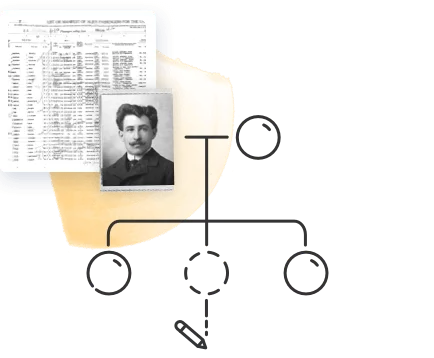
When you first start building a family tree, it can be tempting to race ahead, adding relatives, checking off names, and watching the branches grow. However, the tree growing isn’t always as important as what’s on the leaves. The real value comes not just from who is listed, but from how they’re remembered. Once the branches start forming, a deeper question tends to surface: What’s the real story behind each person I add?
Behind every name is a life, and the more detail you can include, the more real those once distant ancestors begin to feel. This can mean anything from birthplaces, religious names, family photos, or even small snippets from newspapers on major or minor life events. These small pieces come together to help tell your family’s story.
So, whether you’re building your first few branches or trying to piece together a mystery relative, including the right kind of information early on makes the roots of your tree stronger, clearer, and more meaningful as branches continue to be added.
Key Takeaways
- Begin with the essential details: full names, dates of birth and death, and locations.
- Use estimates when exact data isn’t available (e.g., “circa 1890,” “northern Italy”).
- Add photos, religious names, and sources to enrich each profile.
- Double-check for namesakes and cultural naming conventions.
- Always cite where your information came from.
What Are the Basic Facts to Include in a Family Tree?
Before you start adding historical records, stories, or photos, it helps to have a strong foundation. Certain core facts make it easier to track individuals accurately, connect across generations, and avoid confusion when names or locations are repeated.
These details are the anchor points, or essential roots of your tree.
-
Full Legal Names (and Variations)
Whenever possible, include the person’s full birth name. This helps distinguish individuals and improves search results in historical records. Be mindful of:
- Spelling changes or anglicized versions over time
- Name changes after marriage, immigration, or religious conversion
- Common nicknames (e.g., “Lizzie” for Elizabeth) that may appear in some records
If someone is known by multiple names, include them as alternates or in notes.
2. Dates of Birth and Death
These are the cornerstones of genealogical research. Even an approximate date gives valuable context. Use full dates when known, but don’t hesitate to write “circa 1850” or “before 1900” if that’s all you can confirm.
Birth and death years are essential for:
- Separating relatives with the same name
- Understanding generational timelines
- Identifying which records might apply to whom
3. Places of Birth, Death, and Residence
Locations bring your family history to life. A name alone is generic — but when paired with “born in County Kerry” or “died in Chicago,” it becomes rooted in place and time.
Start with:
- City, county, and country (when known)
- Regions or provinces, if specific towns are missing
- Known residences listed in the census or military records
Even broad entries, such as “Southern Italy” or “likely Galicia,” are useful and can be refined later. Also, keep in mind that if exact dates aren’t available, estimations can be just as valuable. Use “circa” (often abbreviated as ca. or c.) to indicate an approximate date, like “c. 1875.” For locations, you can list a region (e.g., “southern Poland”) or province when a town is unknown.
If you have questions about sources, this article offers some helpful guidance: What is the difference between primary and secondary genealogical sources?
What Other Details Help Tell the Story?
Once you’ve locked in names, dates, and locations, it’s time to go deeper. These additional pieces of information can help flesh out who each person was, especially for future relatives who might not recognize the name but will connect with the life.
-
Religious, Cultural, and Ceremonial Names
Many people had more than one name, especially in cultures with naming ceremonies or religious traditions. Someone known as “John” on legal documents might be listed as “Giovanni” in baptismal records or “Yohanan” in religious ones.
Adding these alternate names can:
- Improve your chances of finding matching historical records
- Reveal cultural or linguistic ties
- Clarify identity when similar names appear in the same region
It’s also a great way to honor the heritage behind the name, particularly for Jewish, Catholic, Orthodox, and other families with distinct naming customs.
-
Visuals: Photographs and Artifacts
A tree becomes much more engaging when you can attach a face to a name. Try including:
- Portraits or group family photos
- Scanned letters, recipes, or heirlooms
- Gravestone or monument images
Even one photo can help a descendant feel a deeper connection to an ancestor. Many family historians also use annotated images (e.g., “This is Grandpa Joe in front of the old family store”) to add context and memory to their documentation.
-
Notes, Stories, and Side Facts
Not every detail fits neatly into a date field — and that’s where notes shine. Did someone run a bakery, survive a war, or speak 6 languages? Did they emigrate twice, or raise 12 kids? Add those facts in a story box or custom field.
These additions can:
- Make ancestors memorable
- Offer leads for future research
- Help preserve oral history from living relatives
A good rule of thumb: if it’s been told at a family gathering, it belongs in the tree — even if there’s a big asterisk attached.
-
Sources and Supporting Documents
Whether it’s a birth certificate, military draft record, or naturalization file, linking source documents helps validate the facts and adds historical texture. It also makes your research more useful to others in your family.
To keep your records organized, MyHeritage allows you to link scanned documents or use citation fields to document the source of each fact.
What If I Don’t Know the Exact Date or Place?
One of the most common hurdles in family research is uncertainty. Maybe a birth record doesn’t exist. Maybe the family name changed after immigration. Or maybe the only clue is a handwritten note from decades ago. That’s okay — educated estimates are not only acceptable, they’re essential to building a usable family tree.
How to Use “Circa” and Other Approximations
If you’re unsure of an exact year, use “circa” (abbreviated as c. or ca.) before the year — for example, c. 1880. This signals that the date is an estimate, often based on indirect evidence. Some common sources for rough dating include:
- Ages listed on the census or military records
- Gaps between siblings’ birth years
- Obituaries or gravestone inscriptions
- Marriage or immigration records (which often include age at time of event)
It’s better to provide a thoughtful estimate than to leave a field blank, and you can always update it later if new evidence appears.
What If I Only Know a Region or Country?
Similarly, if you’re missing a specific town but know the person came from a region or country, it’s still worth adding. Not every document lists a specific town, and borders have changed over time. In these cases:
- Use the broadest known location (e.g., “Galicia,” “Northern Italy,” or “possibly Bavaria”)
- Mention historic regions even if they no longer exist (e.g., “Austro-Hungarian Empire”)
- Add question marks or asterisks in your notes if something is especially uncertain
Even vague locations can help narrow down search results, as they provide context to a person’s story. Immigration patterns, languages spoken, and religious affiliations are often tied to geography.
For more background on how populations were documented before standardized records, check out: How Did Countries Document Their Populations Before Censuses and Vital Records?
So, What’s the Most Important Part of a Family Tree?
The truth is, every detail matters. A date adds context. A photo adds memory. A name tells a story. The most important part moves beyond records toward capturing an actual, real, lived life as fully as possible.
Whether you’re listing great-grandparents from memory or tracking down 19th-century immigration papers, the facts you gather help future generations understand where they come from and how their story began.
The truth is, each name is a doorway, and each date, photo, or document you find is a small piece of the puzzle that builds your ancestor’s story. With every detail you add, no matter how small, you turn your family tree into a living archive.
Ready to start filling in the details? Build your tree on MyHeritage and begin discovering the stories that shaped your family’s journey.
FAQs on Information to Include in Your Family Tree
How do I mark estimated dates in a family tree?
Use the word “circa” or the abbreviation “c.” before the year (e.g., c. 1880). This shows that the date is approximate and helps avoid confusion later. Estimates are helpful when confirmed records are missing.
What if multiple people in my tree have the same name?
Use birth/death dates, locations, and relationships to distinguish them. Many families reused names across generations, so it’s common to have several “John Smiths” in a row. Add notes if needed to avoid mix-ups.
Should I include people I don’t have full information on?
Yes! Partial entries are still valuable. Even if you’re missing a date or place, it’s okay to include someone and update their details later. Just be transparent about what’s known and what’s estimated.
Can I include adopted or non-biological relatives?
Absolutely. A family tree reflects both bloodlines and relationships. Include adoptive parents, step-siblings, and others who played a key role in someone’s life—just label their relationship clearly for context.
What’s the best way to cite my sources?
You can link to scanned records, note the name of the archive, or even mention who in your family shared the information. This helps future researchers understand the origin of your data and its reliability.




